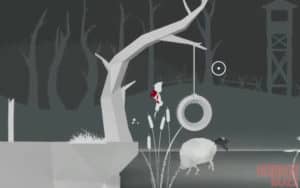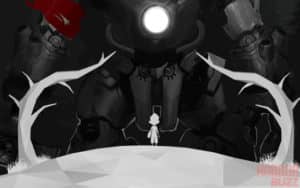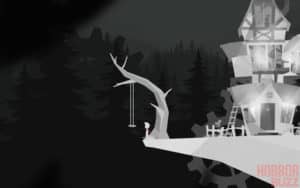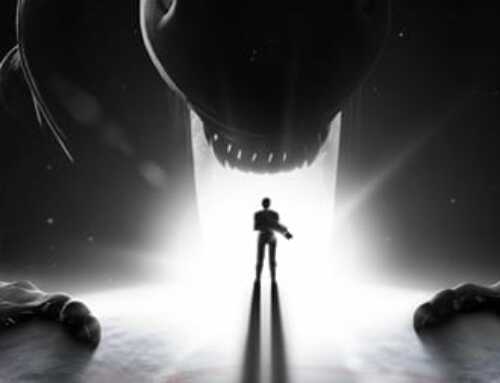“Albert and Otto: The Adventure Begins” has a lot going for it. It’s got a very interesting silhouette-based aesthetic, a rather unique and creepy setting (Germany in 1939), and classic platforming gameplay. What could possibly go wrong? A whole lot, as it turns out.
The story in “Albert and Otto” is not very easy to follow. Not a whole lot is actually told to the player within the game itself. Instead, most of the information I have been able to gather about the story of the game is from its Steam page. As mentioned, it takes place in Germany during the rise of the Third Reich. The player takes control of a young boy named Albert as he chases after a little girl with rabbit ears who keeps showing up and then ominously disappearing. Some places say that this girl is supposed to be Albert’s sister, but others don’t and the game itself doesn’t seem interested in explaining that. Throughout the game, the player finds drawings that have been left behind by the girl and these are the primary method of advancing the story. However, they’re pretty much just little kid’s drawings that don’t necessarily tell a coherent story. Along the way Albert picks up a stuffed rabbit named Otto which gives him magic powers for some reason. One final note about the game’s story: I honestly would not have thought of this as a horror game if it weren’t tagged as such on Steam. Obviously someone thinks this game is scary, but I just do not see it.
 “Albert and Otto” looks great. However, it’s aesthetic is pretty much ripped wholesale from a couple of other indie platformers, “Limbo” and “Tulpa.” Both of those games feature that same flat, silhouette aesthetic as “Albert and Otto,” and “Tulpa” even features similar surreal touches with giant gears strewn about everywhere. Both of those other games, however, went all-in with their flat looks, whereas “Albert and Otto” is actually 3D graphics presented in a way that tries to make them look very flat. However, this really just makes the game look like a game intended for release on the original PlayStation when you can see the blocky polygons that make up the objects, or how poorly rendered Otto’s eyes are. The developer claims that the game’s visual style was inspired by early Tim Burton movies, but given that he also alludes to “Limbo” in that same interview, I can’t help but feel that there’s a pretty strong connection there.
“Albert and Otto” looks great. However, it’s aesthetic is pretty much ripped wholesale from a couple of other indie platformers, “Limbo” and “Tulpa.” Both of those games feature that same flat, silhouette aesthetic as “Albert and Otto,” and “Tulpa” even features similar surreal touches with giant gears strewn about everywhere. Both of those other games, however, went all-in with their flat looks, whereas “Albert and Otto” is actually 3D graphics presented in a way that tries to make them look very flat. However, this really just makes the game look like a game intended for release on the original PlayStation when you can see the blocky polygons that make up the objects, or how poorly rendered Otto’s eyes are. The developer claims that the game’s visual style was inspired by early Tim Burton movies, but given that he also alludes to “Limbo” in that same interview, I can’t help but feel that there’s a pretty strong connection there.
 For most of the game, I was thinking that the sound in “Albert and Otto” was pretty nice. It was the game’s saving grace. Sure it wasn’t much, but it was a solid ambient score. Then out of nowhere in this one room where you have to solve a puzzle involving a magnet, “Horst Wessel Leid” started playing. For anyone who isn’t familiar with that title off the top of their head, it’s the Nazi national anthem. Sure, the game takes place in Germany in 1939, but it really doesn’t touch on the Nazis enough in any other place to justify the inclusion of that song as anything other than poor taste. In fact, other than the blurb about the game on its Steam page, this is really the only Nazi element to this game. It’s jarring, out of place, and brings nothing to the game.
For most of the game, I was thinking that the sound in “Albert and Otto” was pretty nice. It was the game’s saving grace. Sure it wasn’t much, but it was a solid ambient score. Then out of nowhere in this one room where you have to solve a puzzle involving a magnet, “Horst Wessel Leid” started playing. For anyone who isn’t familiar with that title off the top of their head, it’s the Nazi national anthem. Sure, the game takes place in Germany in 1939, but it really doesn’t touch on the Nazis enough in any other place to justify the inclusion of that song as anything other than poor taste. In fact, other than the blurb about the game on its Steam page, this is really the only Nazi element to this game. It’s jarring, out of place, and brings nothing to the game.
The gameplay is riddled with problems as well. The jumping feels unsatisfying to me, like Albert can’t quite jump high or far enough without the double jump. This wouldn’t be a huge issue in most games, but it can be pretty dire for a platforming game like this. Albert carries a gun, but the shooting mechanic is underused and also not very satisfying. It’s only used for occasionally shooting giant crows or knocking down crates from threadbare ropes. Once you get the ability to electrify Otto, this does not provide any protection from crows for some reason. The electricity mechanic is kind of wonky anyway, since if Otto is electrified and then touches something it doesn’t seem to count, instead he has to touch it and then electrify. No explanation for this is given. Eventually the player acquires telekinesis, but the controls for this are incredibly finicky, especially compared to the sluggishness of controlling Albert. Oftentimes when you need to place a rock on a switch or something with telekinesis it will instead fly off the screen because you were moving the mouse just a little to fast when you let go of the button. The ability to separate Albert and Otto to solve puzzles is pretty cool, but “Tulpa” already did that same thing a year earlier. Occasionally, the game’s flat aesthetic makes it difficult or impossible to tell if an object is in the foreground or background, whether you can pass through it or not.“Albert and Otto” uses a checkpoint system, but some of the checkpoints are absurdly far apart, sometimes combined with a series of puzzles where mistiming any one of them leads back to the checkpoint. To me, this felt like artificial difficulty whose sole purpose is to make the game long enough that finishing it takes just a little over two hours, which is generally the cut off for amount of time you can have played a game and still get a refund for it on Steam. Maybe I’m just being cynical, though.
 I really wanted to like “Albert and Otto.” I like the aesthetic even if it’s not original. The setting has promise. The gameplay is a tried and true formula. However, in its attempts to emulate other, better games, “Albert and Otto” fails to build on its own strengths.
I really wanted to like “Albert and Otto.” I like the aesthetic even if it’s not original. The setting has promise. The gameplay is a tried and true formula. However, in its attempts to emulate other, better games, “Albert and Otto” fails to build on its own strengths.
You can purchase Albert and Otto from the official website here.







